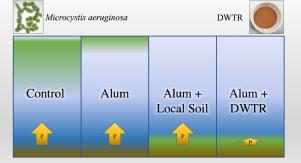Water Research ( IF 11.4 ) Pub Date : 2021-10-22 , DOI: 10.1016/j.watres.2021.117792 Anthony C Kuster 1 , Brian J Huser 2 , Somjate Thongdamrongtham 3 , Surapol Padungthon 4 , Rittirong Junggoth 5 , Anootnara T Kuster 5

|
The combination of a low dose of coagulant with a ballast that can inactive phosphorus (P) in lake sediment—a technique known as “flock and lock”—is one method for restoration of eutrophic lakes. The effectiveness of a drinking water treatment residual (DWTR) as a ballast in flock and lock was assessed using assays of eutrophic lake water from Thailand dominated by Microcystis aeruginosa cyanobacteria colonies by measuring changes in chlorophyll-a, pH, and zeta potential. P sorption isotherms were developed from long-term batch equilibrium experiments; desorption of nutrients and metals was assessed via leaching experiments; and morphological changes to cellular structure were assessed using scanning electron microscopy. Results showed that combining DWTR with a low dose of aluminum sulfate (0.6-4.0 mg Al/L) effectively sank 74-96% of Microcystis, with DWTR dose (50-400 mg/L), initial chlorophyll-a concentration (92-976 µg/L), pH (7.4-9.3), and alkalinity (99-108 ppm CaCO3) identified as factors significantly associated with sinking efficacy. P sorption capacity of the DWTR (7.12 mg/g) was significantly higher than a local soil (0.33 mg/g), enabling the DWTR to inactivate P in lake sediment. Desorption of Al, Fe, Ca and N from the DWTR was estimated to contribute to a marginal increase in concentrations of those compounds in the water column of a small shallow lake (1.2, 0.66, 53.4, and 0.07 µg/L, respectively) following a simulated application. Therefore, pre-treated DWTRs may be a viable alternative ballast in the flock and lock approach to lake restoration, supplementing or replacing modified local soils or lanthanum modified clays.
中文翻译:

饮用水处理残留物作为压载物沉没热带湖水中的微囊藻蓝藻和灭活磷
将低剂量混凝剂与可以使湖泊沉积物中的磷 (P) 失活的压载物相结合——这种技术被称为“flock and lock”——是恢复富营养化湖泊的一种方法。使用以铜绿微囊藻为主的泰国富营养化湖水的测定,评估了饮用水处理残留物 (DWTR) 作为畜群和船闸压舱物的有效性通过测量叶绿素 a、pH 和 zeta 电位的变化来观察蓝藻菌落。P 吸附等温线是从长期批次平衡实验中得出的;通过浸出实验评估营养物和金属的解吸;使用扫描电子显微镜评估细胞结构的形态变化。结果表明,DWTR 与低剂量硫酸铝 (0.6-4.0 mg Al/L) 相结合,可有效地沉没 74-96% 的微囊藻,DWTR 剂量 (50-400 mg/L),初始叶绿素-a浓度 (92- 976 µg/L)、pH (7.4-9.3) 和碱度 (99-108 ppm CaCO 3) 被确定为与下沉效率显着相关的因素。DWTR 的 P 吸附能力 (7.12 mg/g) 显着高于当地土壤 (0.33 mg/g),使 DWTR 能够灭活湖泊沉积物中的 P。据估计,从 DWTR 中解吸 Al、Fe、Ca 和 N 会导致这些化合物在小型浅湖水柱中的浓度略有增加(分别为 1.2、0.66、53.4 和 0.07 µg/L),如下所示:一个模拟的应用程序。因此,预处理的 DWTR 可能是一种可行的替代压载物,用于湖泊修复、补充或替代改良的当地土壤或镧改良粘土的羊群和锁闭方法。











































 京公网安备 11010802027423号
京公网安备 11010802027423号